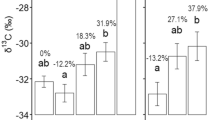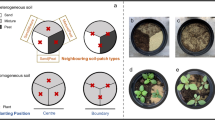Abstract
Allelochemicals released by invasive plants contribute to the successful invasion of new habitats. However, the relationship between allelopathic effects and competitive ability of invasive plants has not been characterized. We quantified the neighbor effects of Wedelia trilobata (family: Asteraceae) and the allelopathic effects of its leaf litter on two Asteraceae competitor species (invasive Eupatorium catarium and non-invasive Lactuca sativa) and on its own ramet growth. The seed germination rate and seedling biomass of the two competitor species decreased following treatment with W. trilobata leaf extracts. When co-cultured with W. trilobata, the total biomass of the two competitor species significantly decreased regardless of whether leaf extracts were present. Under low plant density co-culture conditions, W. trilobata leaf extracts enhanced the inhibitory effects on E. catarium. In contrast, W. trilobata leaf extracts promoted the growth of W. trilobata adventitious roots, resulting in increased competitive ability. Therefore, W. trilobata growth was promoted by its own allelochemicals in leaf extracts, whereas the growth of the invasive and non-invasive competitors was inhibited by the same chemicals. These responses facilitated the invasion by W. trilobata. Our study demonstrates that leaf litter of invasive plants may inhibit the growth of neighboring species to enhance the competitive ability of the invasive plants during the early stages of invasion.





Similar content being viewed by others
References
Aguiar MR, Lauenroth WK, Peters DP (2001) Intensity of intra- and inter-specific competition in coexisting shortgrass species. J Ecol 89:40–47. doi:10.1046/j.1365-2745.2001.00523.x
Bais HP, Vepachedu R, Gilroy S, Callaway RM, Vivanco JM (2003) Allelopathy and exotic plant invasion: from molecules and genes to species interactions. Science 301:1377–1380. doi:10.1126/science.1083245
Bauer JT, Shannon SM, Stoops RE, Reynolds HL (2012) Context dependency of the allelopathic effects of Lonicera maackii on seed germination. Plant Ecol 213:1907–1916. doi:10.1007/s11258-012-0036-2
Belz RG, Hurle K (2004) A novel laboratory screening bioassay for crop seedling allelopathy. J Chem Ecol 30:175–198. doi:10.1023/B:JOEC.0000013190.72062.3d
Blossey B, Notzold R (1995) Evolution of increased competitive ability in invasive nonindigenous plants: a hypothesis. J Ecol 83:887–889. doi:10.2307/2261425
Brose U, Tielborger K (2005) Subtle differences in environmental stress along a flooding gradient affect the importance of inter-specific competition in an annual plant community. Plant Ecol 178:51–59. doi:10.1007/s11258-004-2487-6
Callaway RM, Aschehoug ET (2000) Invasive plants versus their new and old neighbors: a mechanism for exotic invasion. Science 290:521–523. doi:10.1126/science.290.5491.521
Callaway RM, Ridenour WM (2004) Novel weapons: invasive success and the evolution of increased competitive ability. Front Ecol Environ 2:436–443. doi:10.1890/1540-9295(2004)002[0436:NWISAT]2.0.CO;2
Callaway RM, Ridenour WM, Laboski T, Weir T, Vivanco JM (2005) Natural selection for resistance to the allelopathic effects of invasive plants. J Ecol 93:576–583. doi:10.1111/j.1365-2745.2005.00994.x
Chai TT, Ngoi JC, Wong FC (2013) Herbicidal potential of Eichhornia crassipes leaf extract against Mimosa pigra and Vigna radiata. Int J Agric Biol 15:835–842.
Dorning M, Cipollini D (2006) Leaf and root extracts of the invasive shrub, Lonicera maackii, inhibit seed germination of three herbs with no autotoxic effects. Plant Ecol 184:287–296. doi:10.1007/s11258-005-9073-4
He WM, Feng YL, Ridenour WM, Thelen GC, Pollock JL, Diaconu A, Callaway RM (2009) Novel weapons and invasion: biogeographic differences in the competitive effects of Centaurea maculosa and its root exudate (±)-catechin. Oecologia 159:803–815. doi:10.1007/s00442-008-1234-4
Hoagland DR, Arnon DI (1950) The water-culture method for growing plants without soil. Circ Calif Agric Exp Stn 347:1–32
Inderjit Seastedt T, Callaway R, Pollock J, Kaur J (2008) Allelopathy and plant invasions: traditional, congeneric, and bio-geographical approaches. Biol Invasions 10:875–890. doi:10.1007/s10530-008-9239-9
IUCN (2001) 100 of the World’s worst invasive alien species. Invasive Species Specialist Group, Auckland
Junhirun P, Pluempanupat W, Bullangpoti V (2011) Toxicological study of Wedelia trilobata (Asteraceae) extracts as alternative control strategies for Plutella xylostella (Lepidoptera: Plutellidae). Commun Agric Appl Biol Sci 77:721–725
Karlson AML, Naslund J, Ryden SB, Elmgren R (2011) Polychaete invader enhances resource utilization in a species-poor system. Oecologia 166:1055–1065. doi:10.1007/s00442-011-1936-x
Levine JM, Vila M, D’Antonio CM, Dukes JS, Grigulis K, Lavorel S (2003) Mechanisms underlying the impacts of exotic plant invasions. P Roy Soc B Biol Sci 270:775–781. doi:10.1098/rspb.2003.2327
Li ZY, **e Y (2002) Invasive alien species in China. China Forest Publishing House, Bei**g (in Chinese)
Li ZH, Wang Q, Ruan X, Pan CD, Jiang DA (2010) Phenolics and plant allelopathy. Molecules 15:8933–8952. doi:10.3390/molecules15128933
Mangla S, Sheley RL, James JJ, Radosevich SR (2011) Intra- and inter-specific competition among invasive and native species during early stages of plant growth. Plant Ecol 212:531–542. doi:10.1007/s11258-011-9909-z
Meisner A, de Boer W, Cornelissen JHC, van der Putten WH (2012) Reciprocal effects of litter from exotic and congeneric native plant species via soil nutrients. PLoS One 7:e31596. doi:10.1371/journal.pone.0031596
Nie C, Luo S, Zeng R, Mo M, Li H, Lin C (2005) Allelopathic potential of Wedelia trilobata L.: effects on germination, growth and physiological parameters of rice. New South Wales (Australia): Fourth World Congress on Allelopathy, 1–60
Qi SS, Dai ZC, Zhai DL, Chen SC, Si CC, Huang P, Wang RP, Zhong QX, Du DL (2014a) Curvilinear effects of invasive plants on plant diversity: plant community invaded by Sphagneticola trilobata. PLoS One 9:e113964. doi:10.1371/journal.pone.0113964
Qi SS, Dai ZC, Miao SL, Zhai DL, Si CC, Huang P, Wang RP, Du DL (2014b) Light limitation and litter of an invasive clonal plant, Wedelia trilobata, inhibit its seedling recruitment. Ann Bot Lond 114:425–433. doi:10.1093/aob/mcu075
Qian H, Ricklefs RE (2006) The role of exotic species in homogenizing the North American flora. Ecol Lett 9:1293–1298. doi:10.1111/j.1461-0248.2006.00982.x
Qin RM, Zheng YL, Valiente-Banuet A, Callaway RM, Barclay GF, Pereyra CS, Feng YL (2013) The evolution of increased competitive ability, innate competitive advantages, and novel biochemical weapons act in concert for a tropical invader. New Phytol 197:979–988. doi:10.1111/nph.12071
Ridenour WM, Vivanco JM, Feng YL, Horiuchi J, Callaway RM (2008) No evidence for trade-offs: Centaurea plants from America are better competitors and defenders. Ecol Monogr 78:369–386. doi:10.1890/06-1926.1
SAS Institute Incorporated (2004) SAS/STAT User’s Guide. Version 9.1. SAS Institute Incorporated, Cary, North Carolina, USA
Si CC, Dai ZC, Lin Y, Qi SS, Huang P, Miao SL, Du DL (2014) Local adaptation and phenotypic plasticity both occurred in Wedelia trilobata invasion across a tropical island. Biol Invasions 16:2323–2337. doi:10.1007/s10530-014-0667-4
Song LY, Chow WS, Sun LL, Li CH, Peng CL (2010) Acclimation of photosystem II to high temperature in two Wedelia species from different geographical origins: implications for biological invasions upon global warming. J Exp Bot 61:4087–4096. doi:10.1093/jxb/erq220
Vivanco JM, Bais HP, Stermitz FR, Thelen GC, Callaway RM (2004) Biogeographical variation in community response to root allelochemistry: novel weapons and exotic invasion. Ecol Lett 7:285–292. doi:10.1111/j.1461-0248.2004.00576.x
Weed AS, Schwarzlander M (2014) Density dependence, precipitation and biological control agent herbivory influence landscape-scale dynamics of the invasive Eurasian plant Linaria dalmatica. J App Ecol 51:825–834. doi:10.1111/1365-2664.12226
Wu AP, Yu H, Gao SQ, Huang ZY, He WM, Miao SL, Dong M (2009) Differential belowground allelopathic effects of leaf and root of Mikania micrantha. Trees Struct Funct 23:11–17. doi:10.1007/s00468-008-0249-0
Young GP, Bush JK (2009) Assessment of the allelopathic potential of Juniperus ashei on germination and growth of Bouteloua curtipendula. J Chem Ecol 35:74–80. doi:10.1007/s10886-008-9585-1
Yu H, Liu J, He WM, Miao SL, Dong M (2011) Cuscuta australis restrains three exotic invasive plants and benefits native species. Biol Invasions 13:747–756. doi:10.1007/s10530-010-9865-x
Yuan YG, Wang B, Zhang SS, Tang JJ, Tu C, Hu SJ, Yong JWH, Chen X (2013) Enhanced allelopathy and competitive ability of invasive plant Solidago canadensis in its introduced range. J Plant Ecol 6:253–263. doi:10.1093/jpe/rts033
Zhang YH, Liu MF, Ling TJ, Wei XY (2004) Allelopathic sesquiterpene lactones from Wedelia trilobata. J Trop Subtrop Bot 12:533–537 (In Chinese)
Acknowledgments
This work was partly supported by the National Natural Science Foundation of China (31170386, 31200316, and 31200317), the Natural Science Foundation of Jiangsu (BK20150503 and BK20150504), the Jiangsu University Research Foundation (14JDG010 and 15JDG032), the Natural Science Research Project of Higher Education of Jiangsu (14KJB610005), the Innovation and Entrepreneurship Training Program for College Students of Jiangsu (201310299024), the Jiangsu Planned Projects for Postdoctoral Research Funds (1501028B), the Project Funded by the Priority Academic Program Development of Jiangsu Higher Education Institutions (PAPD), the Jiangsu Collaborative Innovation Center of Water Treatment Technology and Materials. We would like to thank Si-Chong Chen for her helpful comments and discussions. We thank Jonathan Teichroew for carefully revising an earlier draft of this manuscript. We are grateful to the anonymous reviewers and the journal editors for their comments that have helped to improve this manuscript.
Author information
Authors and Affiliations
Corresponding authors
Ethics declarations
Conflict of interest
The authors declare that they have no conflict of interest.
About this article
Cite this article
Dai, ZC., Wang, XY., Qi, SS. et al. Effects of leaf litter on inter-specific competitive ability of the invasive plant Wedelia trilobata . Ecol Res 31, 367–374 (2016). https://doi.org/10.1007/s11284-016-1344-0
Received:
Accepted:
Published:
Issue Date:
DOI: https://doi.org/10.1007/s11284-016-1344-0




